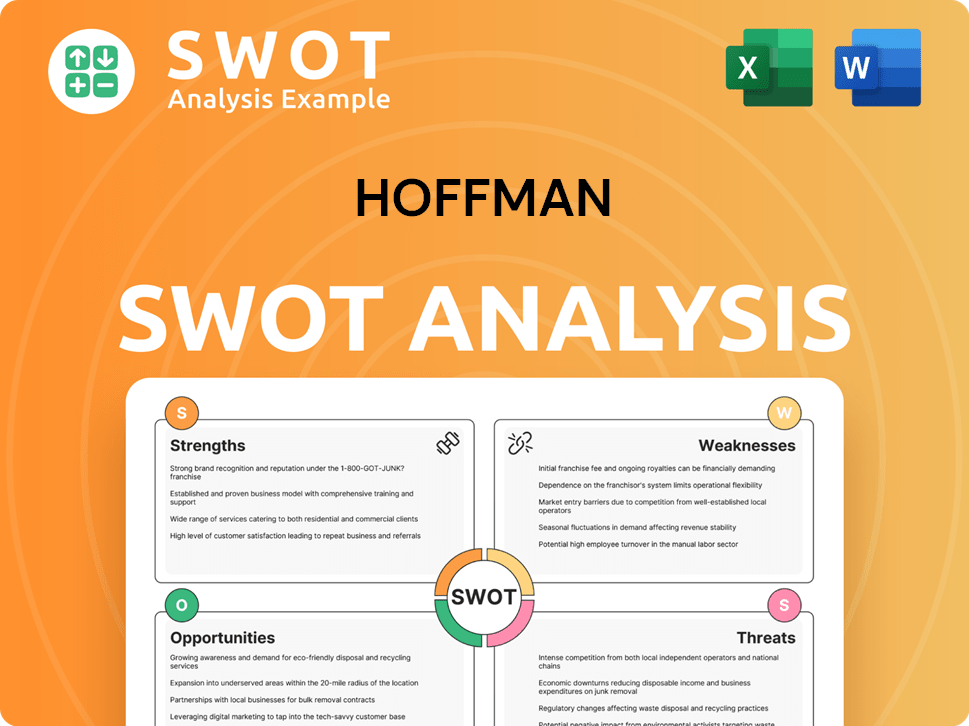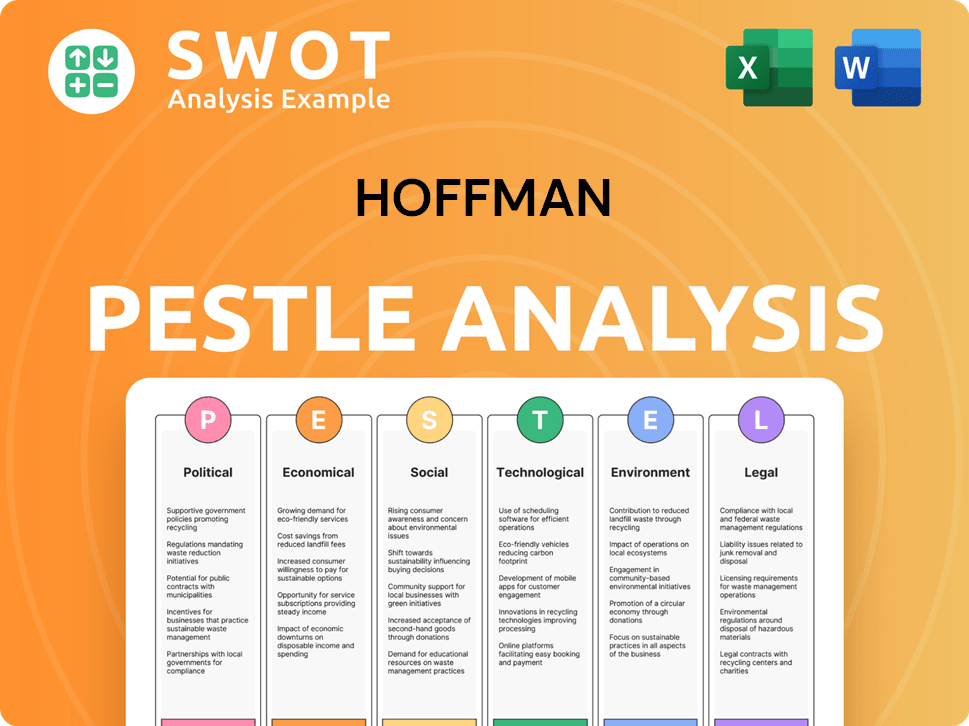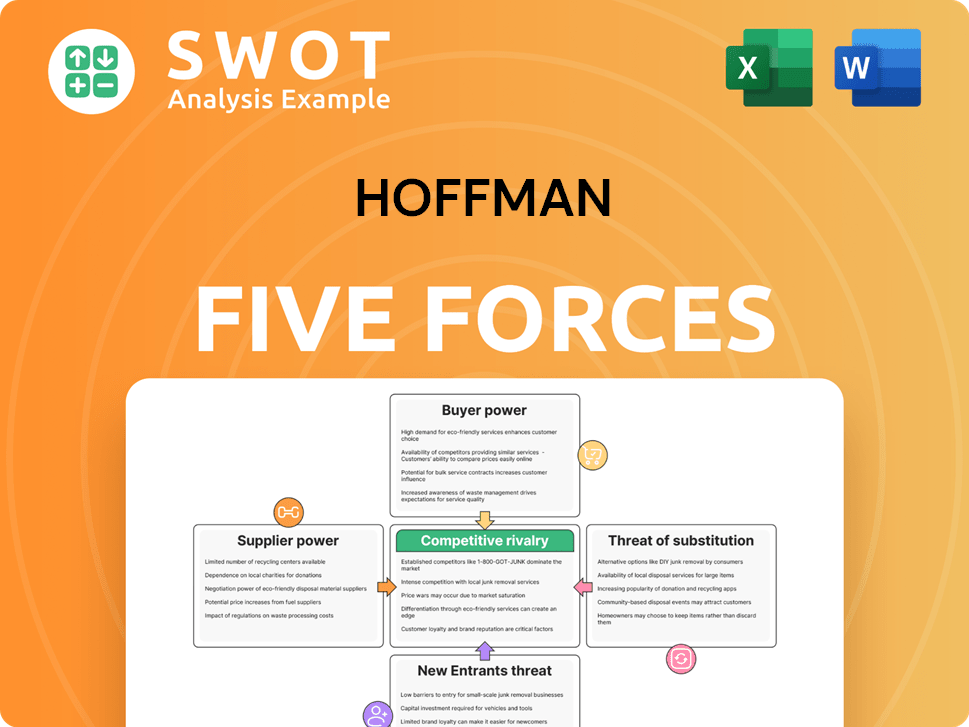Hoffman Bundle
Who Really Owns Hoffman Construction Company?
Understanding Hoffman SWOT Analysis and its ownership is crucial for anyone tracking the construction industry's titans. Founded in 1922, Hoffman Construction Company has built a legacy in the Pacific Northwest and beyond. But who holds the reins of this construction giant, and how has its ownership shaped its impressive growth?

This exploration into Hoffman Company ownership reveals a fascinating story of evolution. From its roots as L.H. Hoffman Company to its current status as a major player, the company's ownership structure offers valuable insights. Discover the key players, the impact of its unique employee-ownership model, and how these factors influence the company's future trajectory. This deep dive will answer questions like: Who is the current owner of Hoffman Company, and what is the Hoffman Company ownership structure?
Who Founded Hoffman?
The story of Hoffman Company ownership begins in 1922, with its foundation by Lee Hawley Hoffman in Portland, Oregon. Initially operating as L.H. Hoffman Company, the firm focused on constructing various types of buildings. This early phase set the stage for what would become a significant player in the construction industry.
Lee Hawley Hoffman's background, including his architecture degree from Harvard College in 1906, and his father's construction experience, provided a solid foundation. The company's early projects included apartment buildings, industrial structures, houses, and schools, showcasing its versatility from the start. This early diversification helped establish the company's presence in the market.
The evolution of Hoffman Company ownership reflects a strategic shift from family control to an employee-owned model. This transition, starting in the mid-20th century, marked a significant change in the company's structure and operational philosophy, influencing its long-term success.
Lee Hawley Hoffman founded the company in 1922. The company began as L.H. Hoffman Company in Portland, Oregon. The company built apartment buildings, industrial structures, houses, and schools.
In 1954, Lee Hawley Hoffman transferred ownership to his sons, Eric and Burns Hoffman. The company was incorporated in Oregon in 1955. Burns Hoffman left the company in 1965.
Eric Hoffman initiated an employee stock ownership plan in 1968. Key officials were allowed to purchase shares. This was a critical step toward the current ownership structure.
Cecil W. Drinkward, an engineer, joined in 1967. Drinkward became a partner and played a crucial role in the company's growth. His expertise helped transform Hoffman into a major commercial builder.
The company transitioned from a sole proprietorship to a family-owned business. The employee stock ownership plan marked a shift toward employee ownership. This structure has significantly influenced the company's culture and operations.
The initial projects included a variety of buildings. This diversification helped establish a strong presence in the construction market. The early focus on different types of construction projects was a key factor.
Understanding the history of Hoffman Company ownership provides insights into its evolution. The transition from family ownership to an employee-owned model has shaped the company's culture and success. For more details on the company's strategic approach, consider reading about the Marketing Strategy of Hoffman.
- Lee Hawley Hoffman founded the company in 1922.
- Ownership transitioned to his sons, Eric and Burns Hoffman, in 1954.
- The employee stock ownership plan began in 1968.
- Cecil W. Drinkward played a key role in the company's growth.
Hoffman SWOT Analysis
- Complete SWOT Breakdown
- Fully Customizable
- Editable in Excel & Word
- Professional Formatting
- Investor-Ready Format

How Has Hoffman’s Ownership Changed Over Time?
The evolution of Hoffman Company ownership reflects a significant shift from its initial family-owned status to its current employee-owned model. A critical turning point occurred in 1992 when Eric Hoffman and Cecil Drinkward transitioned the firm to its employees. This pivotal decision established the foundation for the company's present structure, where the workforce collectively shares in its financial success. This transition highlights a commitment to fostering a culture of shared responsibility and mutual benefit among its team members. This shift is a key factor in understanding the company's operational dynamics and its approach to long-term sustainability.
The employee-ownership model ensures that the majority of the profits are distributed among the workforce. The company's structure limits the number of shareholders to approximately 100 to comply with S-Corporation regulations. Employees selected for ownership are required to invest in the company, which helps to maintain capital within the company. This approach allows for a more generous and widespread distribution of profits. Employees typically become eligible for shares after around 10 years of service. This structure is a core element of the company's identity, fostering a deep commitment to the company's success among its team members.
| Key Event | Year | Impact on Ownership |
|---|---|---|
| Founding of the Company | Early Years | Family-owned business. |
| Transition to Employee Ownership | 1992 | Eric Hoffman and Cecil Drinkward sold the firm to its employees, establishing the current employee-ownership model. |
| Current Status | May 2025 | 100% employee-owned, with employees holding the primary stake. |
As of May 2025, Hoffman Company is entirely employee-owned, with its workforce holding the primary stake in its success. The company's financial performance underscores the effectiveness of its ownership model. In 2023, the company reported a revenue of $5.69 billion, and as of November 2024, revenue reached $5.7 billion. David Drinkward serves as the President and CEO. This Brief History of Hoffman provides additional context on the company's evolution and its leadership.
The company operates under an employee-owned model, fostering a culture of shared responsibility.
- Employee ownership ensures profits are shared among the workforce.
- Shareholders are limited to around 100 to comply with S-Corporation rules.
- Employees invest in the company, helping maintain capital.
- Employees typically receive shares after about 10 years of service.
Hoffman PESTLE Analysis
- Covers All 6 PESTLE Categories
- No Research Needed – Save Hours of Work
- Built by Experts, Trusted by Consultants
- Instant Download, Ready to Use
- 100% Editable, Fully Customizable

Who Sits on Hoffman’s Board?
As a privately held, employee-owned entity, the current board of directors of Hoffman Company is composed of construction industry veterans. While the specific names and individual shareholding percentages are not publicly available, the leadership structure emphasizes a progressive approach to governance. This approach aligns with the company's commitment to its employee-owners and its long-term success. Understanding the dynamics of Hoffman Company ownership is key to grasping its operational philosophy.
The employee-ownership model significantly influences the voting structure. Employees selected for ownership must invest in the company, which gives them a direct stake in its financial performance. This contrasts with publicly traded companies where voting power is directly tied to shares. In the case of the Hoffman Company owner, decision-making likely prioritizes the long-term stability and success of its employees over short-term shareholder demands. Further insights into the Who owns Hoffman Company structure can be found by exploring the company's history and operational practices.
| Board Member Role | Description | Influence |
|---|---|---|
| Board of Directors | Construction industry veterans | Guides the company |
| Employee-Owners | Employees with vested interest | Influences voting structure |
| Tom Peterson | Treasurer, Dispute Resolution Board Foundation | Indicates industry involvement |
The employee stock ownership plan (ESOP) at Hoffman likely empowers employee-owners through various mechanisms, although the specifics of voting rights may vary. This structure reinforces the company's commitment to its employees and long-term stability. For further context, you can explore the Competitors Landscape of Hoffman to understand its market position and competitive dynamics.
Hoffman Company's leadership is deeply rooted in the construction industry, with a board of directors composed of construction veterans. This structure ensures that the company's decision-making aligns with its employee-ownership model. The employee-ownership model inherently influences the voting structure.
- Employee-owners have a vested interest in the company's performance.
- Decision-making prioritizes long-term stability.
- Governance structures empower employee-owners.
- Leadership involvement in industry organizations.
Hoffman Business Model Canvas
- Complete 9-Block Business Model Canvas
- Effortlessly Communicate Your Business Strategy
- Investor-Ready BMC Format
- 100% Editable and Customizable
- Clear and Structured Layout

What Recent Changes Have Shaped Hoffman’s Ownership Landscape?
Recent developments highlight the continued strength and unique ownership structure of Hoffman Construction Company. As of November 2024, the company reported a revenue of $5.7 billion, demonstrating significant financial growth from 2023's $3.9 billion. The company's ranking on ENR's Top 400 Contractors list in 2023, at No. 30, reflects its substantial construction revenue of $5.689 billion.
A key aspect of Hoffman's identity remains its 100% employee-owned status, fostering a culture of deep commitment among its workforce. This ownership model is a significant factor in its success. Recent changes include the retirement of Bart Eberwein as Executive Vice President in March 2024, and the opening of a new location in Lake Oswego, Oregon, in January 2024. Understanding Hoffman's target market can provide additional insights into its business strategy and success.
The construction industry is seeing trends of increased institutional ownership for publicly traded companies. However, Hoffman Construction Company's employee-owned model provides insulation from the pressures of public markets. The company remains focused on delivering complex projects across various sectors, maintaining its unique position in the market. This approach allows Hoffman to prioritize long-term value and employee engagement.
Hoffman Company ownership is unique; it is 100% employee-owned. This structure distinguishes it from many competitors. This ownership model influences its operations and culture.
The employees collectively own Hoffman Company. This arrangement ensures employees have a vested interest in the company's success. This ownership model fosters a strong sense of community.
The ownership structure of Hoffman Company is a key factor in its success. Being employee-owned allows for stability. It also fosters a culture of commitment and long-term vision.
No, Hoffman Company is not publicly traded. Its employee-owned structure means its shares are not available on the stock market. This structure allows for a focus on long-term goals.
Hoffman Porter's Five Forces Analysis
- Covers All 5 Competitive Forces in Detail
- Structured for Consultants, Students, and Founders
- 100% Editable in Microsoft Word & Excel
- Instant Digital Download – Use Immediately
- Compatible with Mac & PC – Fully Unlocked

Related Blogs
- What are Mission Vision & Core Values of Hoffman Company?
- What is Competitive Landscape of Hoffman Company?
- What is Growth Strategy and Future Prospects of Hoffman Company?
- How Does Hoffman Company Work?
- What is Sales and Marketing Strategy of Hoffman Company?
- What is Brief History of Hoffman Company?
- What is Customer Demographics and Target Market of Hoffman Company?
Disclaimer
All information, articles, and product details provided on this website are for general informational and educational purposes only. We do not claim any ownership over, nor do we intend to infringe upon, any trademarks, copyrights, logos, brand names, or other intellectual property mentioned or depicted on this site. Such intellectual property remains the property of its respective owners, and any references here are made solely for identification or informational purposes, without implying any affiliation, endorsement, or partnership.
We make no representations or warranties, express or implied, regarding the accuracy, completeness, or suitability of any content or products presented. Nothing on this website should be construed as legal, tax, investment, financial, medical, or other professional advice. In addition, no part of this site—including articles or product references—constitutes a solicitation, recommendation, endorsement, advertisement, or offer to buy or sell any securities, franchises, or other financial instruments, particularly in jurisdictions where such activity would be unlawful.
All content is of a general nature and may not address the specific circumstances of any individual or entity. It is not a substitute for professional advice or services. Any actions you take based on the information provided here are strictly at your own risk. You accept full responsibility for any decisions or outcomes arising from your use of this website and agree to release us from any liability in connection with your use of, or reliance upon, the content or products found herein.